Osteoarthritis in Canada
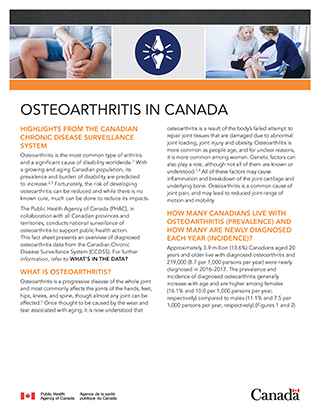
Download the alternative format
(PDF format, 650 KB, 6 pages)
Organization: Public Health Agency of Canada
Date published: September 2020
Highlights from the Canadian Chronic Disease Surveillance System
Osteoarthritis is the most common type of arthritis and a significant cause of disability worldwide.Footnote 1 With a growing and aging Canadian population, its prevalence and burden of disability are predicted to increase.Footnote 2Footnote 3 Fortunately, the risk of developing osteoarthritis can be reduced and while there is no known cure, much can be done to reduce its impacts.
The Public Health Agency of Canada (PHAC), in collaboration with all Canadian provinces and territories, conducts national surveillance of osteoarthritis to support public health action. This fact sheet presents an overview of diagnosed osteoarthritis data from the Canadian Chronic Disease Surveillance System (CCDSS). For further information, refer to What's in the data?
What is Osteoarthritis?
Osteoarthritis is a progressive disease of the whole joint and most commonly affects the joints of the hands, feet, hips, knees, and spine, though almost any joint can be affected.Footnote 1 Once thought to be caused by the wear and tear associated with aging, it is now understood that osteoarthritis is a result of the body's failed attempt to repair joint tissues that are damaged due to abnormal joint loading, joint injury and obesity. Osteoarthritis is more common as people age, and for unclear reasons, it is more common among women. Genetic factors can also play a role, although not all of them are known or understood.Footnote 1Footnote 4 All of these factors may cause inflammation and breakdown of the joint cartilage and underlying bone. Osteoarthritis is a common cause of joint pain, and may lead to reduced joint range of motion and mobility.
How many Canadians live with osteoarthritis (prevalence) and how many are newly diagnosed each year (incidence)?
Approximately 3.9 million (13.6%) Canadians aged 20 years and older live with diagnosed osteoarthritis and 219,000 (8.7 per 1,000 persons per year) were newly diagnosed in 2016–2017. The prevalence and incidence of diagnosed osteoarthritis generally increase with age and are higher among females (16.1% and 10.0 per 1,000 persons per year, respectively) compared to males (11.1% and 7.5 per 1,000 persons per year, respectively) (Figures 1 and 2).
Figure 1: Prevalence (%) of diagnosed osteoarthritis by sex and age group, Canada,Footnote a 2016–2017
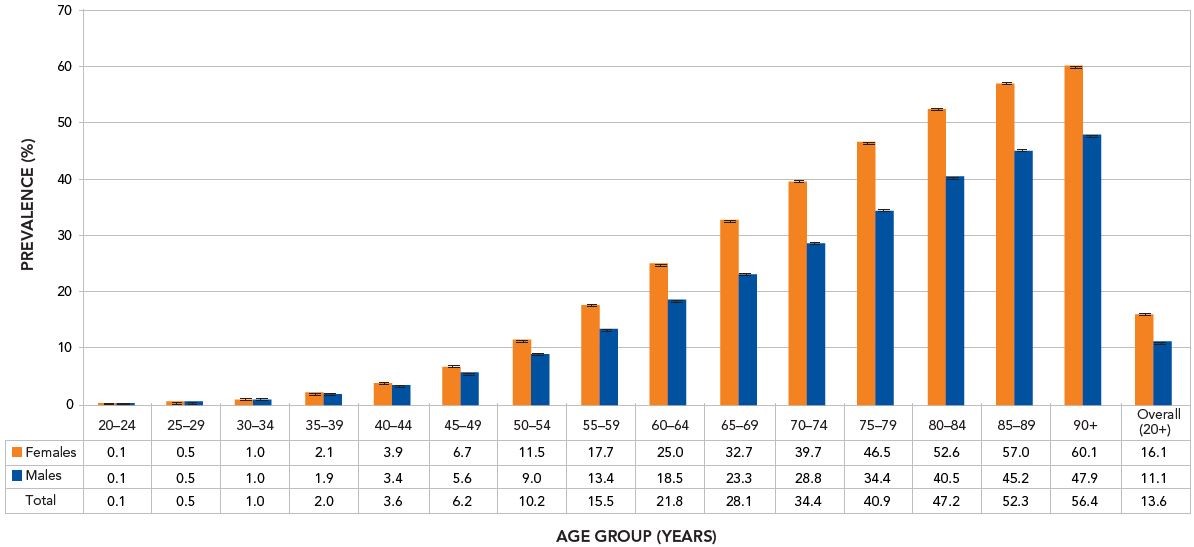
- Footnote a
-
Data from SK were not available for fiscal year 2016–2017.
Notes: The 95% confidence interval shows an estimated range of values which is likely to include the true prevalence 19 times out of 20.
Data Source: Public Health Agency of Canada, using Canadian Chronic Disease Surveillance System data files contributed by provinces and territories, August 2019.
Text description
| Age Group (years) | Prevalence among females for fiscal year 2016-2017 | Prevalence among males for fiscal year 2016-2017 | Total prevalence for fiscal year 2016-2017 |
|---|---|---|---|
| 20-24 | 0.1 | 0.1 | 0.1 |
| 25-29 | 0.5 | 0.5 | 0.5 |
| 30-34 | 1.0 | 1.0 | 1.0 |
| 35-39 | 2.1 | 1.9 | 2.0 |
| 40-44 | 3.9 | 3.4 | 3.6 |
| 45-49 | 6.7 | 5.6 | 6.2 |
| 50-54 | 11.5 | 9.0 | 10.2 |
| 55-59 | 17.7 | 13.4 | 15.5 |
| 60-64 | 25.0 | 18.5 | 21.8 |
| 65-69 | 32.7 | 23.3 | 28.1 |
| 70-74 | 39.7 | 28.8 | 34.4 |
| 75-79 | 46.5 | 34.4 | 40.9 |
| 80-84 | 52.6 | 40.5 | 47.2 |
| 85-89 | 57.0 | 45.2 | 52.3 |
| 90+ | 60.1 | 47.9 | 56.4 |
| Overall (20+) | 16.1 | 11.1 | 13.6 |
Figure 2: Incidence of diagnosed osteoarthritis (per 1,000 persons per year), by sex and age group, Canada,Footnote b 2016–2017
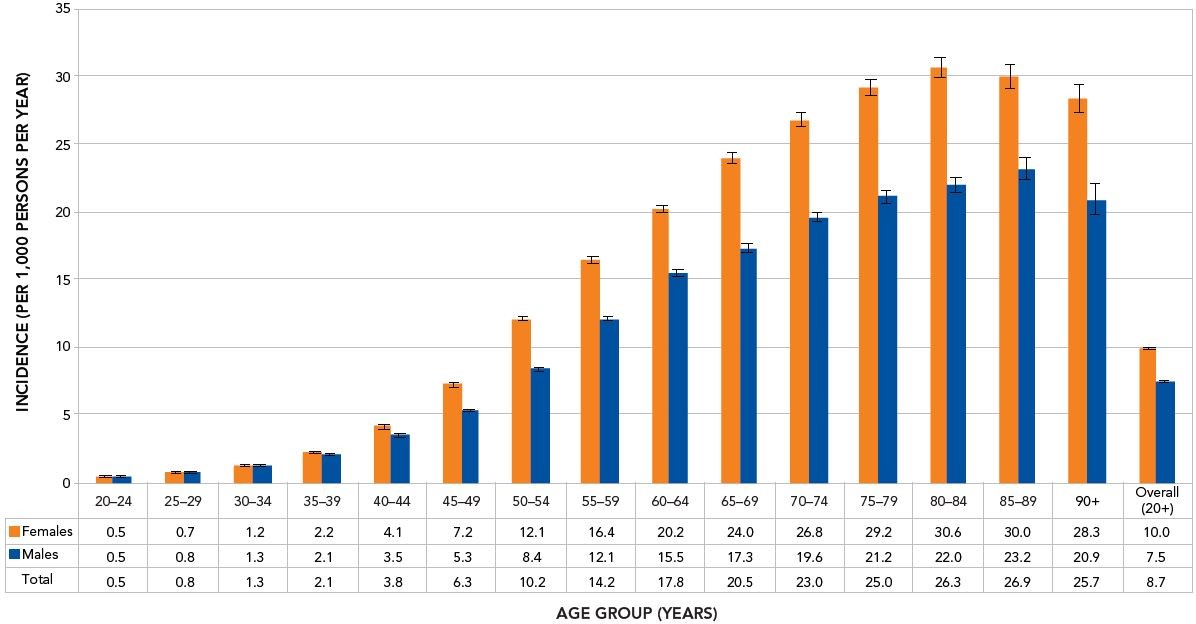
- Footnote b
-
Data from SK were not available for fiscal year 2016–2017.
Notes: The 95% confidence interval shows an estimated range of values which is likely to include the true incidence 19 times out of 20.
Data Source: Public Health Agency of Canada, using Canadian Chronic Disease Surveillance System data files contributed by provinces and territories, August 2019.
Text description
| Age Group (years) | Incidence among females for fiscal year 2016-2017 | Incidence among males for fiscal year 2016-2017 | Total incidence for fiscal year 2016-2017 |
|---|---|---|---|
| 20-24 | 0.5 | 0.5 | 0.5 |
| 25-29 | 0.7 | 0.8 | 0.8 |
| 30-34 | 1.2 | 1.3 | 1.3 |
| 35-39 | 2.2 | 2.1 | 2.1 |
| 40-44 | 4.1 | 3.5 | 3.8 |
| 45-49 | 7.2 | 5.3 | 6.3 |
| 50-54 | 12.1 | 8.4 | 10.2 |
| 55-59 | 16.4 | 12.1 | 14.2 |
| 60-64 | 20.2 | 15.5 | 17.8 |
| 65-69 | 24.0 | 17.3 | 20.5 |
| 70-74 | 26.8 | 19.6 | 23.0 |
| 75-79 | 29.2 | 21.2 | 25.0 |
| 80-84 | 30.6 | 22.0 | 26.3 |
| 85-89 | 30.0 | 23.2 | 26.9 |
| 90+ | 28.3 | 20.9 | 25.7 |
| Overall (20+) | 10.0 | 7.5 | 8.7 |
What are the trends over time?
Between 2007–2008 and 2016–2017, the age-standardized prevalence of diagnosed osteoarthritis increased among females (from 13.4% to 14.1%) and males (from 9.7% to 10.7%) (Figure 3). During the same time period, the age-standardized incidence of diagnosed osteoarthritis decreased from 13.0 to 10.9 per 1,000 persons per year in females and from 9.2 to 8.1 per 1,000 persons per year in males.
Figure 3: Age-standardizedFootnote c prevalence (%) and incidence (per 1,000 persons per year) of diagnosed osteoarthritis among Canadians aged 20 years and older, by sex, Canada,Footnote d from 2007–2008 to 2016–2017
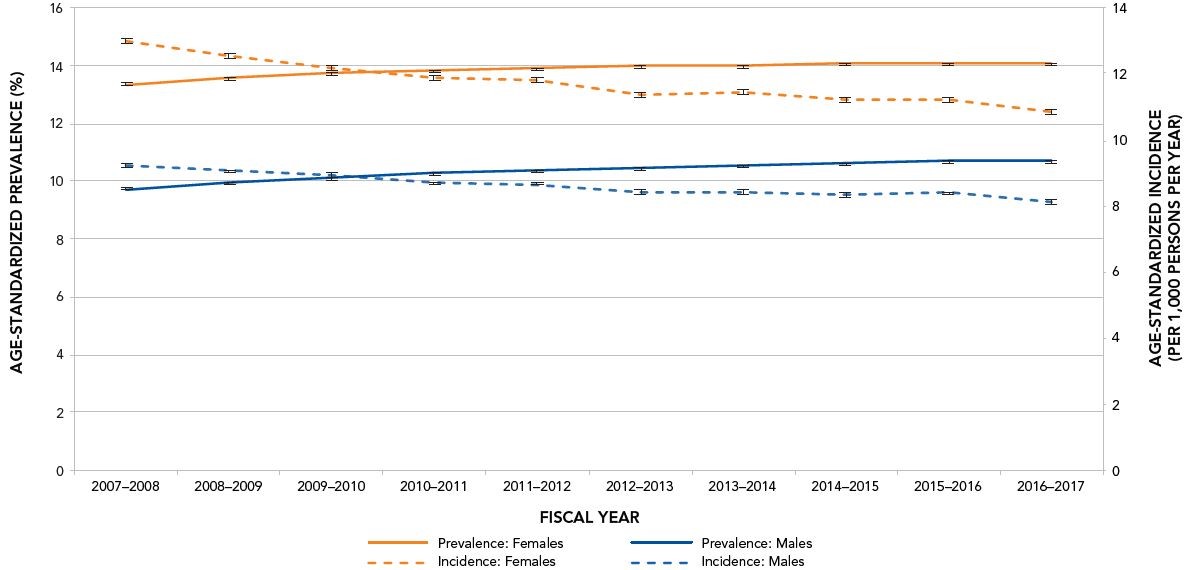
- Footnote c
-
Rates were age-standardized to the 2011 final postcensal Canada population released in 2013.
- Footnote d
-
Data from SK were not available for fiscal year 2016–2017. Data from YT were excluded before fiscal year 2010–2011.
Notes: The 95% confidence interval shows an estimated range of values which is likely to include the true value 19 times out of 20.
Data Source: Public Health Agency of Canada, using Canadian Chronic Disease Surveillance System data files contributed by provinces and territories, August 2019.
Text description
| Fiscal Year | Age-standardized prevalence among females aged 20 years and older | Age-standardized prevalence among males aged 20 years and older | Age-standardized incidence among females aged 20 years and older | Age-standardized incidence among males aged 20 years and older |
|---|---|---|---|---|
| 2007-2008 | 13.4 | 9.7 | 13.0 | 9.2 |
| 2008-2009 | 13.6 | 9.9 | 12.6 | 9.0 |
| 2009-2010 | 13.7 | 10.1 | 12.2 | 8.9 |
| 2010-2011 | 13.8 | 10.2 | 11.9 | 8.7 |
| 2011-2012 | 13.9 | 10.4 | 11.8 | 8.7 |
| 2012-2013 | 14.0 | 10.4 | 11.4 | 8.4 |
| 2013-2014 | 14.0 | 10.5 | 11.4 | 8.4 |
| 2014-2015 | 14.1 | 10.6 | 11.2 | 8.3 |
| 2015-2016 | 14.1 | 10.7 | 11.2 | 8.4 |
| 2016-2017 | 14.1 | 10.7 | 10.9 | 8.1 |
What are the mortality rates (due to any cause of death) among Canadians with or without osteoarthritis?
Osteoarthritis does not typically result in death. However it is of interest to consider mortality due to other causes in people with osteoarthritis because it often affects seniors and is associated with comorbid conditions.Footnote 2 Between 2007–2008 and 2016–2017, mortality rates due to any cause (age-standardized) decreased among females with diagnosed osteoarthritis (8.0 per 1,000 persons per year to 7.6 per 1,000 persons per year) and among males with diagnosed osteoarthritis (12.3 per 1,000 persons per year to 10.7 per 1,000 persons per year) (Figure 4). Rates were consistently higher among males compared to females.
Over the surveillance period, the age-standardized all-cause mortality rate ratios (i.e., comparing individuals with, versus without, diagnosed osteoarthritis) were relatively stable ranging from 1.1 to 1.2 for females and around 1.2 for males. While rate ratios were similar among females and males, they showed a slight increase in mortality risk among those with diagnosed osteoarthritis.
Figure 4: Age-standardizedFootnote e all-cause mortality rates (per 1,000 persons per year) and rate ratios among Canadians aged 20 years and older with and without diagnosed osteoarthritis (OA), Canada,Footnote f from 2007–2008 to 2016–2017
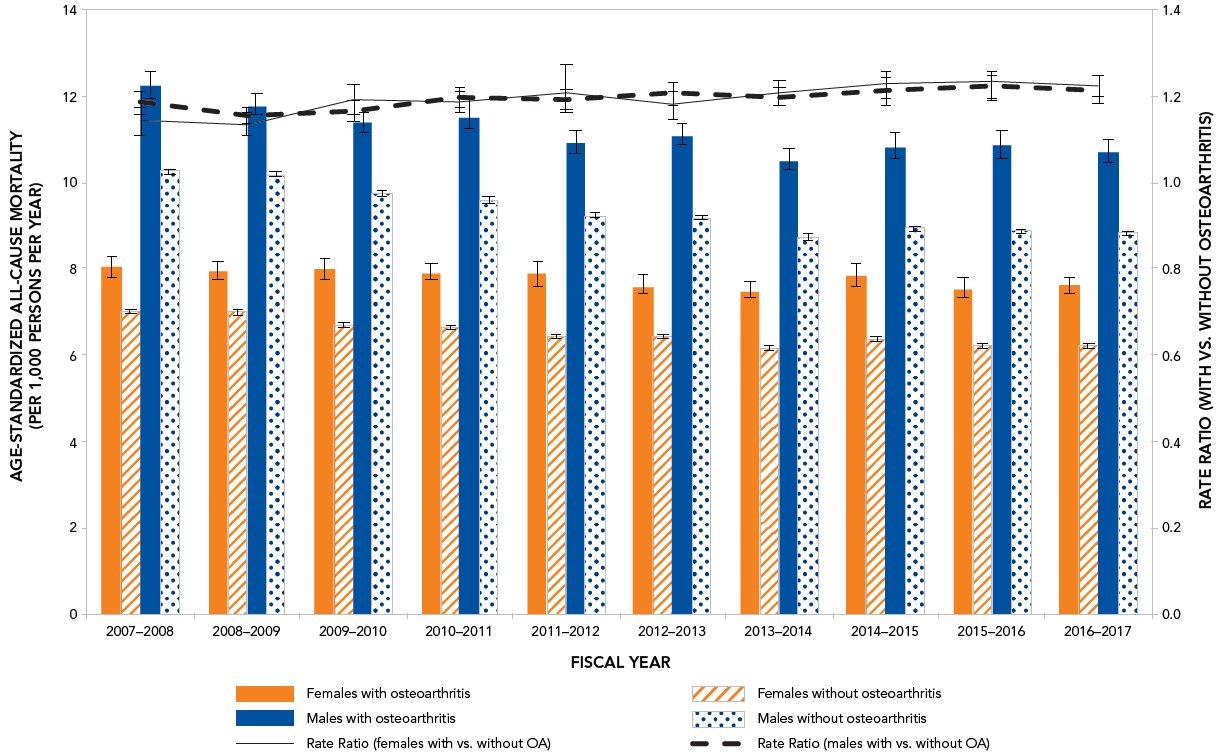
- Footnote e
-
Rates were age-standardized to the 2011 final postcensal Canada population released in 2013.
- Footnote f
-
Data from SK were not available for fiscal year 2016–2017. Data from YT were excluded before fiscal year 2010–2011.
Notes: The 95% confidence interval shows an estimated range of values that is likely to include the true value 19 times out of 20.
Data Source: Public Health Agency of Canada, using CCDSS data files contributed by provinces and territories, August 2019.
Text description
| Fiscal Year | Age-standardized all-cause mortality among females aged 20 years and older with diagnosed osteoarthritis | Age-standardized all-cause mortality among females aged 20 years and older without diagnosed osteoarthritis | Age-standardized all-cause mortality among males aged 20 years and older with diagnosed osteoarthritis | Age-standardized all-cause mortality among males aged 20 years and older without diagnosed osteoarthritis | Rate ratio among females aged 20 years and older (females with versus without diagnosed osteoarthritis) | Rate ratio among males aged 20 years and older (males with versus without diagnosed osteoarthritis) |
|---|---|---|---|---|---|---|
| 2007-2008 | 8.0 | 7.0 | 12.3 | 10.3 | 1.1 | 1.2 |
| 2008-2009 | 7.9 | 7.0 | 11.8 | 10.2 | 1.1 | 1.2 |
| 2009-2010 | 8.0 | 6.7 | 11.4 | 9.7 | 1.2 | 1.2 |
| 2010-2011 | 7.9 | 6.7 | 11.5 | 9.6 | 1.2 | 1.2 |
| 2011-2012 | 7.9 | 6.4 | 10.9 | 9.2 | 1.2 | 1.2 |
| 2012-2013 | 7.6 | 6.4 | 11.1 | 9.2 | 1.2 | 1.2 |
| 2013-2014 | 7.5 | 6.2 | 10.5 | 8.7 | 1.2 | 1.2 |
| 2014-2015 | 7.8 | 6.4 | 10.8 | 8.9 | 1.2 | 1.2 |
| 2015-2016 | 7.5 | 6.2 | 10.9 | 8.9 | 1.2 | 1.2 |
| 2016-2017 | 7.6 | 6.2 | 10.7 | 8.8 | 1.2 | 1.2 |
How can osteoarthritis be managed?
To reduce the risk of developing osteoarthritis, or delay its onset, it is important to maintain a healthy body weight, keep joints healthy and muscles strong by staying physically active, but protect joints from injury and overuse.Footnote 1 While there is no cure for osteoarthritis, therapeutic exercise, weight management and other strategies can help relieve symptoms.Footnote 1Footnote 5 Pain medications may also be helpful.Footnote 1Footnote 6 In severe cases, surgery including joint replacement may be recommended.
What do national data on osteoarthritis tell us?
- The prevalence and incidence of diagnosed osteoarthritis are more common among females compared to males and increase with age.
- The increase in prevalence of diagnosed osteoarthritis may be due to a number of factors including that Canadians are living longer.
Acknowledgements
This work was made possible through collaboration between PHAC and all Canadian provincial and territorial governments and expert contribution from the CCDSS Arthritis Working Group. Results and interpretations reported in this fact sheet are those of the authors. No endorsement by the provinces and territories is intended or should be inferred.
How to learn more
Visit: Canada.ca search "arthritis" or "osteoarthritis"
Get data: Canadian Chronic Disease Surveillance System Data Tool
Follow us: @GovCanHealth
Like us: @HealthyCdns
More: visit the Arthritis Society
What's in the data?
The data used in this publication are from the Canadian Chronic Disease Surveillance System (CCDSS), a collaborative network of provincial and territorial chronic disease surveillance systems, supported by the Public Health Agency of Canada (PHAC).
The CCDSS identifies chronic disease cases from provincial and territorial administrative health databases, including physician billing claims and hospital discharge abstract records, linked to provincial and territorial health insurance registry records using a unique personal identifier. Data on all residents eligible for provincial or territorial health insurance are captured in the health insurance registries.
While CCDSS data reflect the health status of the Canadian population, they may also reflect changes in data collection methods, coding and classification systems, or clinical and billing practices. These factors must also be taken into consideration when interpreting time trends.
Definition of diagnosed osteoarthritis in the CCDSS
Canadians aged 20 years and older are identified as having diagnosed osteoarthritis if they have: at least one hospitalization record or at least two physician claims in a five-year period with an International Classification of Diseases (ICD-9 or ICD-10) code for osteoarthritis.
References
- Footnote 1
-
Public Health Agency of Canada (PHAC). Life with arthritis in Canada: a personal and public health challenge. Ottawa (ON): PHAC; 2010 [cited 2019 Mar 20]. Available from: https://www.canada.ca/en/public-health/services/chronic-diseases/arthritis/life-arthritis-canada-a-personal-public-health-challenge.html
- Footnote 2
-
Birtwhistle R, Morkem R, Peat G, Williamson T, Green ME, Khan S, et al. Prevalence and management of osteoarthritis in primary care: an epidemiologic cohort study from the Canadian Primary Care Sentinel Surveillance Network. CMAJ Open. 2015 Jul;3(3):E270.
- Footnote 3
-
Woolf AD. Global burden of osteoarthritis and musculoskeletal diseases. BMC Musculoskelet Disord. 2015 Dec;16(Suppl 1) S3.
- Footnote 4
-
Kraus VB, Blanco FJ, Englund M, Karsdal MA, Lohmander LS. Call for standardized definitions of osteoarthritis and risk stratification for clinical trials and clinical use.
- Footnote 5
-
Dunlop DD, Song J, Semanik PA, Chang RW, Sharma L, Bathon JM, et al. Objective physical activity measurement in the osteoarthritis initiative: are guidelines being met? Arthritis Rheum. 2011 Nov;63(11):3372–82.
- Footnote 6
-
Bijlsma JW, Knahr K. Strategies for the prevention and management of osteoarthritis of the hip and knee. Best Pract Res Clin Rheumatol. 2007 Feb;21(1):59–76.